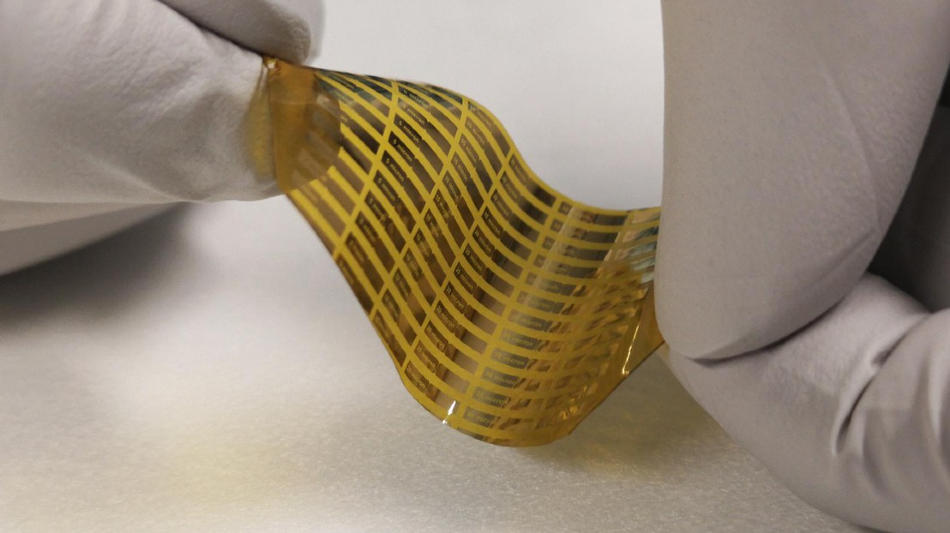Mar 26 2020
EPFL scientists have created a new nanodevice that works around 100 times faster than the transistors used in computers, and over 10 times faster than that of existing fastest transistors.
 The nanoscale terahertz wave generator can be implemented on flexible substrates. Image Credit: © EPFL/POWERlab.
The nanoscale terahertz wave generator can be implemented on flexible substrates. Image Credit: © EPFL/POWERlab.
The nanodevice helps to generate high-power terahertz (THz) waves that are useful in a wide range of applications, such as sensing, imaging, high-speed wireless communications, etc. Incidentally, it is very difficult to produce THz waves.
The device is capable of high-power picosecond operations that also hold enormous potential to certain sophisticated medical treatment methods like cancer treatment. The pioneering compact source studied by the EPFL team has been recently described in the Nature journal and shows promise for novel applications.
THz waves oscillate at frequencies ranging from 100 billion to 30 trillion cycles per second, and fall between infrared and microwave radiation in the electromagnetic spectrum.
THz waves are valued for their unique properties: for example, these waves can penetrate clothing, paper, walls, and wood, and they can even detect air pollution. THz sources could redefine security as well as medical imaging systems. In addition, THz sources are capable of carrying large amounts of data that could lead to faster wireless communications.
THz waves can be described as a kind of non-ionizing radiation, which means that they do not pose any threat to human health. A few airports are already using this technology to scan passengers and identify harmful substances and objects.
But in spite of their excellent potential, THz waves are not extensively utilized because they are cumbersome and expensive to generate. However, EPFL researchers have developed a novel technology that can possibly change all that.
Headed by Professor Elison Matioli, the research group at the Power and Wide-band-gap Electronics Research Laboratory (POWERlab) has developed a novel nanodevice (1 nm is equal to one-millionth of a millimeter) that is capable of producing very high-power signals in only a few picoseconds, or one-trillionth of a second—which generates high-power THz waves.
This latest technology can be mounted on a flexible medium or a chip, and it is believed that it would one day be installed in various hand-held devices, including smartphones. Mohammad Samizadeh Nikoo, a PhD student at the POWERlab is the first author of the study, which was published in the Nature journal.
How it Works
The low-cost, small, and fully electric nanodevice generates high-intensity waves from a very small source almost immediately. It functions by creating a strong “spark,” with the voltage increasing from 10 V (or lower) to 100 V in a picosecond range.
The device can produce this powerful spark almost constantly, which means it can generate up to 50 million signals per second. When the system is fixed to antennas, it can generate and radiate high-power THz waves.
The nanodevice includes a pair of metal plates that are placed very close to each other, as low as 20 nm apart. Upon applying a voltage, electrons travel toward one of the metal plates, thereby creating a nanoplasma.
As soon as the voltage reaches a specific threshold, the electrons are produced almost immediately to the second metal plate. Due to this fast movement facilitated by such rapid switches, a high-intensity pulse is created and this, in turn, generates high-frequency waves.
Traditional electronic devices can only switch at rates of up to 1 V/ps—which is too slow to create high-power THz waves. On the other hand, the latest nanodevice, which can be nearly 10 times faster than today’s electronic devices, can produce high-energy as well as high-frequency pulses.
Normally, it’s impossible to achieve high values for both variables. High-frequency semiconductor devices are nanoscale in size. They can only cope with a few volts before breaking out. High-power devices, meanwhile, are too big and slow to generate terahertz waves. Our solution was to revisit the old field of plasma with state-of-the-art nanoscale fabrication techniques to propose a new device to get around those constraints.
Elison Matioli, Professor, Power and Wide-band-gap Electronics Research Laboratory, EPFL
Matioli added that the novel device drives all the variables to the extreme: “High-frequency, high-power and nanoscale aren’t terms you’d normally hear in the same sentence.”
These nanodevices, on one side, bring an extremely high level of simplicity and low-cost, and on the other side, show an excellent performance. In addition, they can be integrated with other electronic devices such as transistor. Considering these unique properties, nanoplasma can shape a different future for the area of ultra-fast electronics.
Mohammad Samizadeh Nikoo, Study First Author and PhD Student, Power and Wide-band-gap Electronics Research Laboratory, EPFL
The new technology could have extensive applications beyond producing THz waves. “We’re pretty sure there’ll be more innovative applications to come,” concluded Matioli.
A plasma-based nanodevice to generate powerful terahertz waves
Video Credit: EPFL.